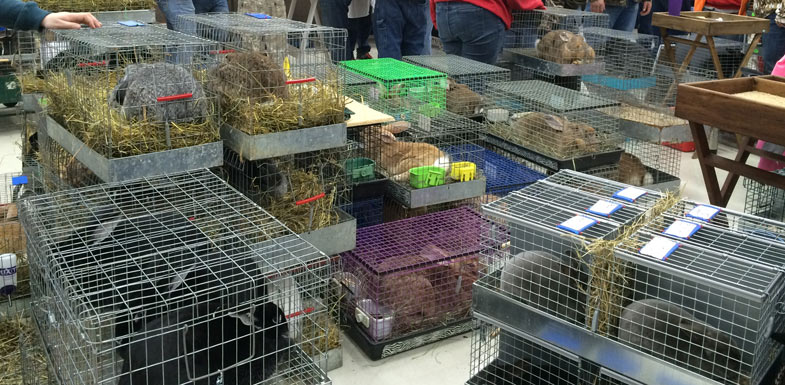In order for any breed of animal to be fairly judged, there must be a guideline to go by. That guideline should be used across-the-board, so that a particular list of qualities may be deemed breed-appropriate in regards to what the “perfect” specimen should look like; providing information to those judging & raising them a set goal to work towards while developing & improving specific traits of that breed.
American Rabbit Breeders Association (ARBA) Shows
There are two classifications of rabbits shown; 4-Class & 6-Class. The 4-class breeds are the smaller or dwarf breeds (typically under 9lbs) & the 6-class are those deemed as commercial, meat, or giant breeds (above 9lbs). Flemish Giants are a 6-Class breed which is shown by division of variety, sex, & age.

A flemish giant show
Recognized varieties
First, there are 7 recognized varieties: Sandy, Fawn, White, Light Grey, Steel Grey, Blue, and Black. While they are being judged, they are first divided into these 7 groups, by color- respectfully. Next, they are separated by sex; bucks & does. Finally, they are further separated by age; junior, intermediate, & senior. The basic order of Flemish Giant show presentation is this:
Sandy (& so on for each color there-after – ) *to be presented in reverse order to list below
a. Jr Doe – minimum weight of 6.5 pounds with no minimum age requirements
b. Jr Buck – minimum weight of 6.5 pounds with no minimum age requirements
c. Int Doe – 6 to 8 months of age with no weight requirements
d. Int Buck – 6 to 8 months of age with no weight
e. Sr Doe – minimum 8 months old & weight of 14 pounds/ no max on weight
f. Sr Buck – minimum of 8 months old & weight of 13 pounds / no max on weight
Judging a Flemish Giant

A judge inspects a flemish giant during a show
Once that is done, he will then re-evaluate all of those 1st place winners to choose the best pair for that entire variety; awarding those as “best of variety & best opposite sex of variety”. Next, he will re-call all of those Best of Variety winners to be re-evaluated a 3rd time. He will then pick only two – a buck & a doe – which he is most impressed with. Those two will then be awarded as the “best of breed’ and ‘best opposite sex of breed.” After this has been done, the “Best of Breed” winner is eligible to wait until the very end of the show, after a best of breed winner has been chosen for every breed being shown. Those rabbits then are divided into classes; competing for best 4 & best 6 class, followed by the competition between the best 4 & best 6 class winners, to determine which one wins the award for Reserve in Show & the Best In Show.
